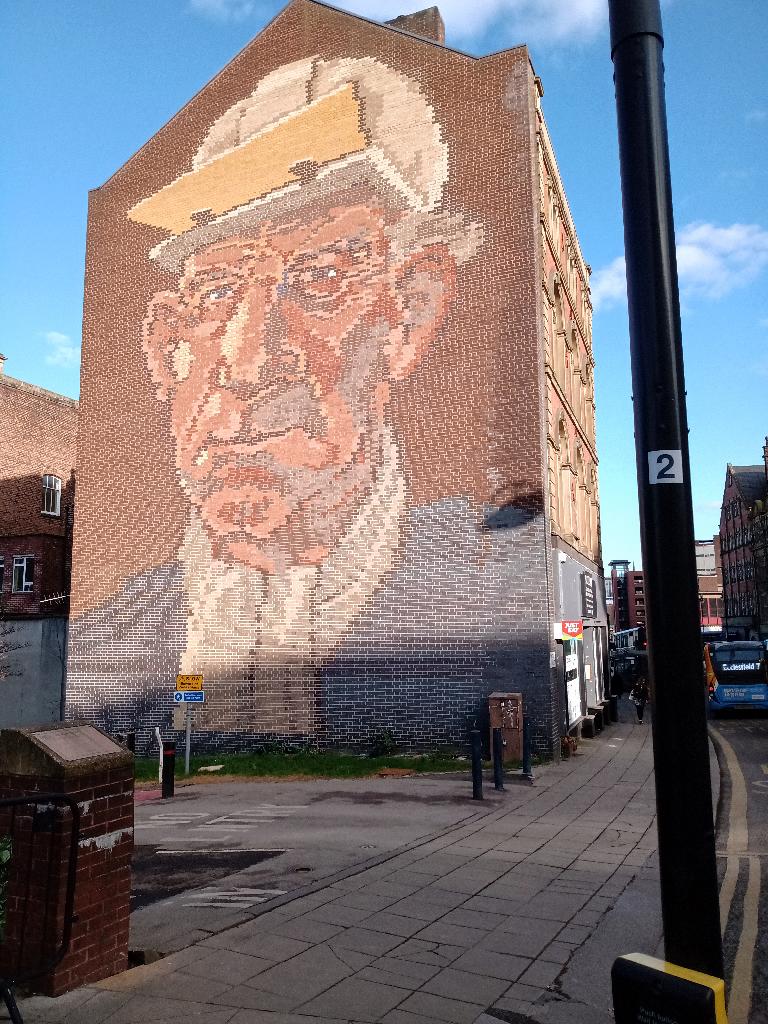Men of Steel
Writing Challenge 2023
Posted by Chris Sissons on Jul 12, 2023
Writing Challenge » Chris Sissons

The photo is of a wall. If you go along the road to the right, it’s a few yards to the site of the Castle (see Day 11). According to the interpretation board, it is made of 30 000 bricks of 8 varieties plus 5 types of mortar!
Most people, at first glance, think he’s a coal miner. But look again. His helmet does not include a lamp, instead, it sports a visor. He is a steelman.
I’ve written about Sheffield grinders. Steel was another matter of great importance to the development of the city. The grinders tended to be small businesses set up by Little Mesters in their own workshops. To this day development in the industrial areas is complicated by land parcelled into small holdings. The making of things from iron and steel pre-dated the making of steel on a large scale.
The Little Mesters were very independent and it was understood that Mondays were a saint’s day. Saint Mondays were an extra day off for maintenance and the odd pint or two. This was a headache for the big millowners who wanted their workers to work the full week.
This meant they had to employ outsiders from strange exotic places, like Lincolnshire.
Steelmaking progressed from cementation furnaces that produced blister steel to crucible steel and then to huge blast furnaces. Blister steel was produced by layering iron with coke and so it was full of bubbles. This made it difficult to work, eg to make watch springs.
Crucible steel was much higher quality and it was a Sheffield invention. The iron was melted in crucibles and so had fewer bubbles which made it easier to work. But it made relatively small ingots. The huge blast furnaces produced larger amounts that could be used for bigger projects, eg munitions, which made Sheffield a target during the Second World War.
Harry Brearley stumbled upon a formula for stainless steel in 1913. This was another major development for the city and special steels are still a specialty in Sheffield despite the 1980s massive decline in steel production.
The work at the blast furnaces and rolling mills was heavy but with long periods of downtime. This meant there was an opportunity for Industrial Chaplaincy, founded by Bishop Hunter and Ted Wickham in the late 40s. While the steel was melting, the men would meet with chaplains in Bible Classes.
The works were communities of men who knew each other. When there was a vacancy, they could recommend a son, nephew or godson for the job. (There were a few vacancies for women on the admin side of things and the same applied.) This was still true in the 1990s but probably not now. There were shortages of labour post-war and so immigrants, mainly from the Indian sub-continent, were invited in. Yes, there was discrimination and it took ages to introduce greater fairness in recruitment. The employers preferred recommendations from the workforce because if a young new worker caused trouble, his Dad or Uncle could give him a clip round the ear’oil.
Sheffield had loads of pubs, especially close to the steelworks. It was hot work and so the men sweated and needed to replenish their body fluids. The pubs would open when the shifts ended at any time of day because everyone saw the need for it.
Steel transformed the city and the loss of most of the steel works since the 1980s had transformed the city again. Many families remember but there is also the work of artists. One ex-steelworker contemplating a sculpture depicting a crucible steel team at the Meadowhall shopping centre, wondered whether there will ever be a similar work depicting a shop assistant operating a cash register!
We walk on the ashes of past workers, of cutlerying heroes and steel giants.
This year's Writing Challenge, fueled by prompts, is about the City of Sheffield. Be surprised by what's included and even more surprised by what's left out. This is Post 14 and there are 21 altogether. Share your thoughts and your love for the City in the comments. The first Post 0 is Context: Sheffield. The last post 13 is Hunters Bar. The next post 15 is From Rioting to Supermarket.
Comments
Leave a comment.
Leave a comment.



 )
)